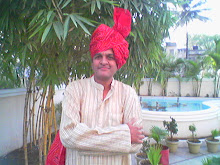

Professor Noel King, Professor Emeritus of History & Comparative Religion of University of California Santa Cruz had visited Pakistan briefly late last year and has kindly forwarded details of his finds of Jain relics. He had made a detailed visit several years ago but had to leave in a hurry due to bad health. Last year's visit was very brief and details given are a little scanty neverthless interesting.Taxila is one of the most important archeological sites of Asia located along the Silk route in Punjab Province of Pakistan. It flourished during the 1st to 5th century AD when it became famous as a major seat of learning of Buddhism. The Stupa shown above is located near the city of Sirkap (severed head) along side many other Buddhist relics. A request has been made to find out why it is called the Jaina Stupa but no information has been forthcoming.
The Lahore Museum has a fine collection of Jain relics mainly of the material collected from the city of Gujranwala and Darkhana. It is believed that Mr Raghavji Virchand Gandhi, the first person to represent Jainism abroad and who attended the first Parliament of World Religions in 1893 in Chicago was supported by the Jain center from this area.
The Lahore Museum has a fine collection of Jain relics mainly of the material collected from the city of Gujranwala and Darkhana. It is believed that Mr Raghavji Virchand Gandhi, the first person to represent Jainism abroad and who attended the first Parliament of World Religions in 1893 in Chicago was supported by the Jain center from this area.
The following murtis are all on display at the Lahore Museum, unfortunately the quality of photographs is not very good and it is difficult to identify the symbol (lancchan) on any of the murtis. Photos: Courtesy Pakistan Tourist Development Corporation
On the road from Rawalpindi to Lahore in the Pothohar area, there are so-called 'Kafir Kots', ruins of old temples. No details of these temples are available but the architecture seems to be Jain.On a near by hill top about 2000 ft high there is a small lake called Shiva Tears for Sati. There are ruins along the hill side up to the top and sorrounding the lake. Many of the building look like monasteries. There is a Shiva statue in the temple in the photograph below but Prof King suspects that the statue may have been of a tirthankar and that a Jain temple was converted to a Hindu temple.
Just a few dozen meters from the Shrine of the Double-Headed Eagle sits the Jain Stupa, a relic of the Sirkap city period (2nd century B.C. to the 2nd century A.D.). The shrine is badly ruined. Nothing of the superstructure survives. The persepolitan columns with lion ornamentation that sit on the four corners were brought here from the ruins of the courtyard.


No comments:
Post a Comment